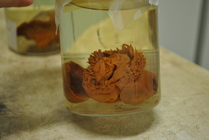WoRMS name details
Stomphia carneola (Stimpson, 1853)
158259 (urn:lsid:marinespecies.org:taxname:158259)
unaccepted
Species
marine, terrestrial
(of Actinia carneola Stimpson, 1853) Stimpson, W. (1853). Synopsis of the marine Invertebrata of Grand Manan: or the region about the mouth of the Bay of Fundy, New Brunswick. <em>Smithsonian Contributions to Knowledge.</em> 6: 1-66, pls. 1-3., available online at https://www.biodiversitylibrary.org/page/32536624
page(s): 7, fig. 1 [details]
page(s): 7, fig. 1 [details]
Distribution Cape Hatteras to Bay of Fundy
Distribution Cape Hatteras to Bay of Fundy [details]
Rodríguez, E.; Fautin, D; Daly, M. (2025). World List of Actiniaria. Stomphia carneola (Stimpson, 1853). Accessed through: World Register of Marine Species at: https://www.marinespecies.org/aphia.php?p=taxdetails&id=158259 on 2025-04-11
Date
action
by
![]() The webpage text is licensed under a Creative Commons
Attribution 4.0 License
The webpage text is licensed under a Creative Commons
Attribution 4.0 License
Nomenclature
original description
(of Actinia carneola Stimpson, 1853) Stimpson, W. (1853). Synopsis of the marine Invertebrata of Grand Manan: or the region about the mouth of the Bay of Fundy, New Brunswick. <em>Smithsonian Contributions to Knowledge.</em> 6: 1-66, pls. 1-3., available online at https://www.biodiversitylibrary.org/page/32536624
page(s): 7, fig. 1 [details]
basis of record Gosner, K. L. (1971). Guide to identification of marine and estuarine invertebrates: Cape Hatteras to the Bay of Fundy. <em>John Wiley & Sons, Inc., London.</em> 693 pp. [pdf copepod and branchiuran :445-455]. (look up in IMIS) [details] Available for editors [request]
[request]
page(s): 7, fig. 1 [details]
basis of record Gosner, K. L. (1971). Guide to identification of marine and estuarine invertebrates: Cape Hatteras to the Bay of Fundy. <em>John Wiley & Sons, Inc., London.</em> 693 pp. [pdf copepod and branchiuran :445-455]. (look up in IMIS) [details] Available for editors
Other
context source (Hexacorallia)
Fautin, Daphne G. (2013). Hexacorallians of the World. (look up in IMIS) [details]
additional source Sebens, K.P. 1998. Marine flora and fauna of the eastern United States. Anthozoa, Actinaria, Corallimorparia, Ceriantharia, and Zoanthidea. NOAA Technical Report NMFS 141. 68 p. (look up in IMIS) [details]
additional source Whiteaves J.F. (1901). Catalogue of the marine Invertebrata of eastern Canada. Geological Survey of Canada, 722, pp. 1-272., available online at https://www.biodiversitylibrary.org/page/12912999
page(s): 40 [details]
additional source den Hartog, J. C. & van der Land, J. (2000-2007). As a contribution to UNESCO-IOC Register of Marine Organisms. (look up in IMIS) [details]
additional source Boone, L. (1934). Scientific Results of the World Cruise of the Yacht 'Alva', 1931, William K. Vanderbilt, Commanding. Crustacea: Stomatopoda and Brachyura. <em>Bulletin of the Vanderberbilt Marine Museum.</em> 5: 1-210, pls. 1-109.
page(s): 66-67 [details] Available for editors [request]
[request]
additional source Verrill, A. E. (1899). Descriptions of imperfectly known and new actinians, with critical notes on other species. American Journal of Science, 7: 41-50, 143-146, 205-218, 375-380
page(s): 206-208 [details]
additional source Parker, G. H. (1900). Synopses of North-American invertebrates. XIII. The Actiniaria. American Naturalist, 34, 747-758
page(s): 753 [details]
additional source Verrill, A. E. (1922). The Actiniaria of the Canadian Arctic Expeditions, with notes on interesting species from Hudson Bay and other Canadian localities. Report on the Canadian Arctic Expedition 1913-1918, 8, G, 89-164
page(s): 118-119 [details]
additional source Integrated Taxonomic Information System (ITIS). , available online at http://www.itis.gov [details]
additional source Fautin, Daphne G. (2013). Hexacorallians of the World. (look up in IMIS) [details]
additional source Sebens, K.P. 1998. Marine flora and fauna of the eastern United States. Anthozoa, Actinaria, Corallimorparia, Ceriantharia, and Zoanthidea. NOAA Technical Report NMFS 141. 68 p. (look up in IMIS) [details]
additional source Whiteaves J.F. (1901). Catalogue of the marine Invertebrata of eastern Canada. Geological Survey of Canada, 722, pp. 1-272., available online at https://www.biodiversitylibrary.org/page/12912999
page(s): 40 [details]
additional source den Hartog, J. C. & van der Land, J. (2000-2007). As a contribution to UNESCO-IOC Register of Marine Organisms. (look up in IMIS) [details]
additional source Boone, L. (1934). Scientific Results of the World Cruise of the Yacht 'Alva', 1931, William K. Vanderbilt, Commanding. Crustacea: Stomatopoda and Brachyura. <em>Bulletin of the Vanderberbilt Marine Museum.</em> 5: 1-210, pls. 1-109.
page(s): 66-67 [details] Available for editors
additional source Verrill, A. E. (1899). Descriptions of imperfectly known and new actinians, with critical notes on other species. American Journal of Science, 7: 41-50, 143-146, 205-218, 375-380
page(s): 206-208 [details]
additional source Parker, G. H. (1900). Synopses of North-American invertebrates. XIII. The Actiniaria. American Naturalist, 34, 747-758
page(s): 753 [details]
additional source Verrill, A. E. (1922). The Actiniaria of the Canadian Arctic Expeditions, with notes on interesting species from Hudson Bay and other Canadian localities. Report on the Canadian Arctic Expedition 1913-1918, 8, G, 89-164
page(s): 118-119 [details]
additional source Integrated Taxonomic Information System (ITIS). , available online at http://www.itis.gov [details]
additional source Fautin, Daphne G. (2013). Hexacorallians of the World. (look up in IMIS) [details]
 Present
Present  Present in aphia/obis/gbif/idigbio
Present in aphia/obis/gbif/idigbio  Inaccurate
Inaccurate  Introduced: alien
Introduced: alien  Containing type locality
Containing type locality
Unreviewed
Diet Generally, anthozoans are primarly carnivorous which prey on sea urchins, gastropods, bivalves, or crustaceans that crawl or swim into their grasp. [details]Distribution Cape Hatteras to Bay of Fundy [details]
Habitat sandy, muddy, or rocky habitats; also may attached themselves to hard parts or products of other organisms (shells) [details]
Reproduction reproduce asexually through longitudinal fission and sexually (protandric hermaphrodites) [details]
Type specimen type specimen from Bay of Fundy [details]
